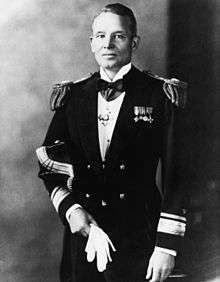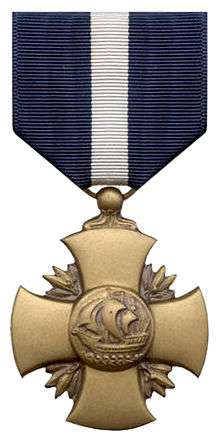Emory S. Land
| Emory S. Land | |
|---|---|
 In this 1936 photo, Land wore the full dress uniform of Rear Admiral, while serving as Chief of the Bureau of Construction and Repair | |
| Birth name | Emory Scott Land |
| Born | January 8, 1879 |
| Died | November 27, 1971 (aged 92) |
| Allegiance |
|
| Service/branch |
|
| Years of service | 1902 - 1946 |
| Rank |
|
| Commands held | Chairman, U.S. Maritime Commission |
| Battles/wars |
World War I World War II |
| Awards |
Navy Cross Navy Distinguished Service Medal |
Vice Admiral Emory Scott Land (January 8, 1879 – November 27, 1971)[1] was an officer in the United States Navy, noted for his contributions to naval architecture, particularly in submarine design. Notable assignments included serving as Chief of the Navy's Bureau of Construction and Repair during the 1930s, and as Chairman of the U.S. Maritime Commission during World War II.
Naval career through World War I
From Cañon City, Colorado, Land graduated from the United States Naval Academy on May 21, 1902. Following two years of sea duty, he became a naval architect specializing in submarine construction.
During World War I, he served on the Board of Devices and Plans connected with Submarines in Warfare, the Board of Standardization of Submarines, and the staff of Admiral William S. Sims, who commanded all U.S. naval forces in European waters.
Land played a key role in the design of the S-class submarines from 1917 to 1919, the United States Navy's first attempt to build a submarine capable of operating with the battle fleet. Land was vice chairman of the Navy's postwar V-boat Plans Committee in 1920. He was awarded the Navy Cross for his work on submarine design and construction and for work in the war zone.
Interwar years and World War II
From October 1, 1932 until April 1, 1937, Land was Chief of the Bureau of Construction and Repair. In this position, he played a major role in submarine development leading to the highly successful fleet boats of World War II.
Land retired in 1937, but on February 18, 1938 he became Chairman of the U.S. Maritime Commission, overseeing the design and construction of the more than 4,000 Liberty ships and Victory ships that flew the U.S. flag during World War II.[2] Land concurrently served as Administrator of the War Shipping Administration (WSA), established by Executive Order 9054 on February 7, 1942.[3] Thus Admiral Land exercised authority over both construction and allocation of non-combatant maritime assets to Army, Navy and commerce.
Admiral Land was also instrumental in overseeing the establishment of the United States Merchant Marine Academy, located in Kings Point, New York as a commissioning source for officers entering the Merchant Marine and Naval Reserve in World War II. Land Hall, located at the Academy, is named in his honor.
Post-war activities
On January 15, 1946, Vice Admiral Emory S. Land resigned as Chairman of the U.S. Maritime Commission. For outstanding services, He was rewarded the Navy's Distinguished Service Medal by the War Department. Land served as President of the Air Transport Association of America from 1946–1957 and worked as a consultant for General Dynamics Corporation until his death in November 1971 at age 92.
Awards and honors

Admiral Land's personal decorations include:
- Navy Cross
- Navy Distinguished Service Medal
- Spanish Campaign Medal
- World War I Victory Medal with Submarine Clasp
- American Defense Service Medal
- American Campaign Medal
- World War II Victory Medal
- Honorary Commander of the Order of the British Empire (CBE) 1921
- Honorary Knight Commander of the Order of the British Empire (KBE) 1945
- Grand Officer Second Class Polonia Restituta presented by Polish Government in Exile
- Honorary Graduate of the United States Merchant Marine Academy
- The submarine tender Emory S. Land (AS-39) was named for him.
References
- ↑ "Emory Scott Land". Arlington National Cemetery Website. 9 December 2006. Retrieved 11 March 2012.
- ↑ Herman, Arthur. Freedom's Forge: How American Business Produced Victory in World War II, pp. 81, 122-4, 180-91, Random House, New York, NY. ISBN 978-1-4000-6964-4.
- ↑ War Shipping Administration (1944). "War Shipping Administration Report to The President, 1944". U.S. Merchant Marine at War. 1944 Report of the War Shipping Administration (Transcribed and formatted by Patrick Clancey, HyperWar Foundation). Retrieved 11 March 2012.
- This article incorporates text from the public domain Dictionary of American Naval Fighting Ships.